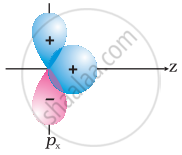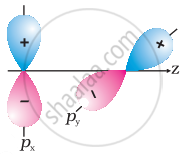Advertisements
Advertisements
प्रश्न
Display electron distribution around the oxygen atom in the water molecule and state the shape of the molecule, also write the H-O-H bond angle.
उत्तर
Electron distribution around oxygen atom in water molecule:

Shape of water molecule: Angular or V-shaped
H–O–H bond angle = 104°35’
APPEARS IN
संबंधित प्रश्न
Draw diagram for bonding in ethene with sp2 Hybridisation.
Draw an orbital diagram of Fluorine molecule
Distinguish between sigma and pi bond.
Give reasons for need of Hybridization
Give a reason for the sigma (σ) bond is stronger than the Pi (π) bond.
Give a reason for carbon is tetravalent in nature.
Mention the steps involved in Hybridization.
The ratio of number of sigma (σ) and pi (л) bonds in 2- butynal is ______.
According to Valence bond theory, a bond between two atoms is formed when ______.
Which of these represents the correct order of their increasing bond order.
The correct order of O – O bond length in hydrogen peroxide, ozone and oxygen is
XeF2 is isostructural with ______.
What is a pi - bond?
Which bond is stronger σ or π? Why?
Considering x-axis as the molecular axis which out of the following will form a sigma bond.
1s and 2py
Which of the following molecule contain 50% p-character of hybrid orbital in C atom?
The number of sigma bonds in vanillin is ____________.
The overlap of orbitals involved in the formation of C - Br bond in vinyl bromide is ______.
If the electronic configuration of an element is 1s2 2s2 2p6 3s2 3p6 3d2 4s2, the four electrons involved in chemical bond formation will be ______.
Why does type of overlap given in the following figure not result in bond formation?
 |
 |
Briefly describe the valence bond theory of covalent bond formation by taking an example of hydrogen. How can you interpret energy changes taking place in the formation of dihydrogen?
Which of the following statements is INCORRECT according to the valence bond theory?
Match List - I with List - II.
| List - I | List - II | ||
| (a) | \[\ce{PCl5}\] | (i) | Square pyramidal |
| (b) | \[\ce{SF6}\] | (ii) | Trigonal planar |
| (c) | \[\ce{BrF5}\] | (iii) | Octahedral |
| (d) | \[\ce{BF3}\] | (iv) | Trigonal bipyramidal |
Choose the correct answer from the options given below.
